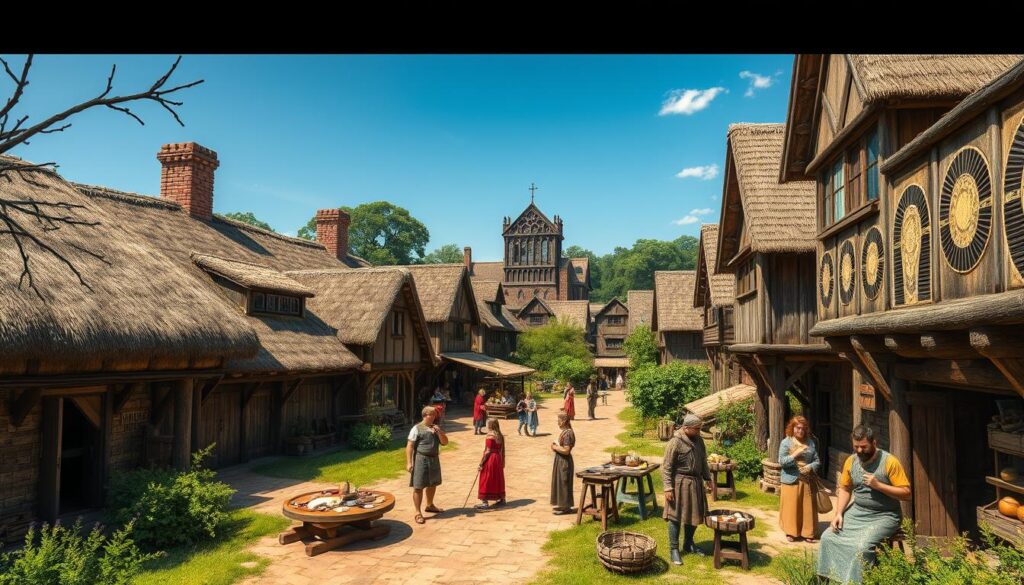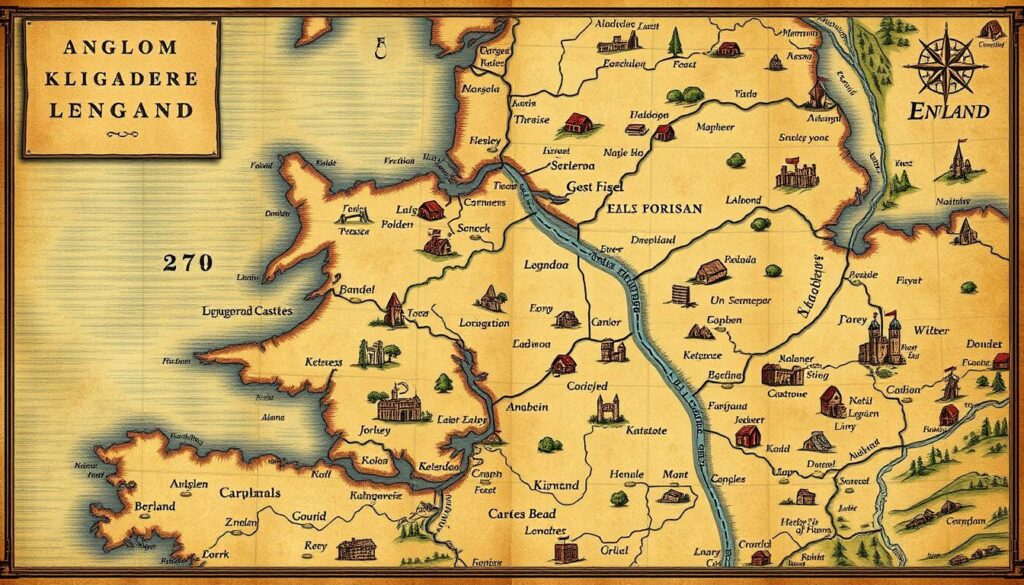The Anglo-Saxon period (circa 410-1066 AD) saw the rise of the Heptarchy. This was seven major Anglo-Saxon kingdoms: Northumbria, Mercia, Wessex, East Anglia, Essex, Sussex, and Kent. By the 9th century, Wessex became the leading kingdom under Alfred the Great. He successfully fought off the Viking invasions.
During this time, Christianity spread across Anglo-Saxon Britain. This was thanks to St. Augustine in 597 AD. The Anglo-Saxon period ended with the Norman Conquest in 1066. Yet, the Anglo-Saxon law, culture, and language left a lasting impact on English history.
Key Takeaways
- The Anglo-Saxon period (circa 410-1066 AD) witnessed the rise of the Heptarchy—seven major Anglo-Saxon kingdoms.
- Wessex emerged as the dominant Anglo-Saxon kingdom by the 9th century under Alfred the Great, who successfully repelled Viking invasions.
- Christianity spread widely across Anglo-Saxon Britain following the mission of St. Augustine in 597 AD.
- Although the Anglo-Saxon period ended with the Norman Conquest in 1066, the enduring legacy of Anglo-Saxon law, culture, and language profoundly shaped the course of English history.
- This article explores the fascinating world of the Anglo-Saxon kingdoms that dominated early medieval Britain.
Introduction to Anglo-Saxon England
The story of Anglo-Saxon England is fascinating. It tells of Germanic tribes arriving in the British Isles after the Romans left. The Angles, Saxons, and Jutes came from across the North Sea. They created their own Anglo-Saxon kingdoms and changed the area’s culture and politics.
The Arrival of Germanic Tribes in Britain
When the Roman Empire weakened, Britain was left without a strong leader. This allowed germanic tribes to move in. The Angles, Saxons, and Jutes, from Denmark, Germany, and the Netherlands, started to settle and take control of different parts of the country.
- The Angles settled in the east, creating “Angleland” or “England”.
- The Saxons took the south, forming kingdoms like Wessex and Sussex.
- The Jutes, though smaller, influenced Kent and the Isle of Wight.
These germanic tribes brought their languages, customs, and ways of ruling. These would shape Anglo-Saxon England for centuries.
The Establishment of Anglo-Saxon Kingdoms
As the germanic tribes settled, they formed Anglo-Saxon kingdoms. These kingdoms fought each other, shaping early medieval Britain.
- Kent, founded by the Jutes, was a key Anglo-Saxon kingdom.
- The Angles created Northumbria in the north. The Saxons made Wessex, Essex, and Sussex in the south.
- Mercia in the Midlands also became a major power in the Anglo-Saxon kingdoms.
These Anglo-Saxon kingdoms had their own cultures and rivalries. They set the stage for a unified Anglo-Saxon England to come.
The Heptarchy: The Seven Main Anglo-Saxon Kingdoms
The term “heptarchy” refers to the seven major Anglo-Saxon kingdoms in Britain during the early medieval period. These kingdoms were key in shaping England’s politics and culture. Each kingdom had its own history and importance.
At the heart of the heptarchy were Northumbria, Mercia, East Anglia, Essex, Kent, Sussex, and Wessex. These kingdoms fought for power, made alliances, and had conflicts. This shows the dynamic and often turbulent nature of Anglo-Saxon England.
The kingdom of Northumbria was in the northern regions and was known for its military strength and cultural achievements. The Lindisfarne Gospels are a famous example. Mercia, in the Midlands, was also powerful and influential.
- The East Anglian kingdom was in the east and was known for its trade and agriculture.
- Essex played a big role in early Christianity in England. Kent and Sussex had their own cultures and politics.
- Wessex, in the southwest, became the most powerful kingdom. It reached its peak under King Alfred the Great.
The heptarchy shows the diversity and complexity of Anglo-Saxon England. It laid the groundwork for the kingdom’s eventual unity under one ruler.
“The heptarchy represents the rich and varied political landscape of early medieval England, where multiple kingdoms vied for supremacy and contributed to the shaping of the nation’s identity.”
Political and Social Structure of Anglo-Saxon Kingdoms
The Anglo-Saxon kingdoms of medieval Britain had a complex system of government. At the top were the anglo-saxon kings, who had a lot of power. They were seen as leaders chosen by God, thanks to their family ties and conquests.
Below the kings, the anglo-saxon nobility played a key role. This group included ealdormen, earls, and thanes. They were wealthy landowners who had a big say in their kingdoms’ decisions.
Societal Organisation and Daily Life
The rest of society was divided into clear groups. Most people were peasants, working on the land. They lived simple lives, farming, raising animals, and making goods in their homes.
The balance of power in Anglo-Saxon England was delicate. Kings and nobles kept control through a system of loyalty and mutual support.
| Social Rank | Description |
|---|---|
| Kings | Absolute rulers, claimed divine right to rule |
| Nobility | Ealdormen, earls, and thanes – landowners with significant political influence |
| Freemen | Prosperous farmers and craftspeople |
| Peasants | Majority of the population, engaged in agriculture and rural industries |
| Slaves | Individuals bound to serve their masters, often prisoners of war |
This complex social structure shaped the anglo-saxon kingdoms. It defined their politics and society during a crucial time in British history.
Religious Transformation: Paganism to Christianity
The Anglo-Saxon kingdoms of England started with pagan beliefs. They had a rich mix of deities and traditions. But, over time, Christianity changed the religious scene.
The Spread of Christianity in Anglo-Saxon England
The change to Christianity was slow. It was helped by Christian missionaries and the conversion of kings and nobles. Saint Augustine, sent by the Pope, was key in spreading the faith.
At first, many Anglo-Saxons resisted Christianity. Their old beliefs were a big part of who they were. But, Christianity’s promise of salvation and its rituals won many over. This led to the christianisation of anglo-saxons.
- The arrival of Christian missionaries, such as Saint Augustine, sent by the Pope to convert the Britons
- The personal conversions of influential kings and nobles, who embraced the Christian faith and encouraged its adoption
- The gradual decline of pagan beliefs and practices as the Christian faith gained traction among the Anglo-Saxon population
The shift from anglo-saxon paganism to anglo-saxon christianity changed England a lot. It affected culture, politics, and society. This big change shaped England’s history for centuries.
The Rise and Fall of Anglo-Saxon Kingdoms
The Anglo-Saxon kingdoms of England saw a remarkable journey. They rose to fame but then faced challenges from outside. Kingdoms like Mercia and Wessex fought for the top spot.
The Anglo-Saxon kingdoms grew strong due to political unity, trade growth, and Christianity’s spread. The Sutton Hoo site shows their wealth and power. It reveals the culture and leadership of that time.
But, the Viking attacks brought the kingdoms down. These attacks shook the region’s politics and society. The story of these kingdoms teaches us about power’s weakness against outside threats.
| Kingdom | Period of Supremacy | Significant Events |
|---|---|---|
| Mercia | 7th-9th centuries | Expansion under King Offa, conflict with Wessex |
| Wessex | 9th-11th centuries | Rise of Alfred the Great, unification of England |
“The history of the Anglo-Saxon kingdoms is one of constant flux, with the balance of power shifting between the various kingdoms as they vied for supremacy.”
The Kingdoms of Anglo-Saxon England
Northumbria: The Powerful Northern Kingdom
Northumbria was a strong kingdom in the north of Anglo-Saxon England. It became powerful in the 7th century. Its rulers left a lasting mark on history.
Edwin was a key ruler of Northumbria. He united Deira and Bernicia, creating a strong kingdom. His rule saw a cultural and religious boom, with beautiful cathedrals and Christianity spreading.
Mercia: The Midlands Powerhouse
Mercia was in the heart of Anglo-Saxon England. It was a major power in the 7th and 8th centuries. Its location and military strength made it a force to be reckoned with.
- Offa, a Mercian ruler, expanded his kingdom. He took over East Anglia and the Kingdom of Kent.
- The capital, Tamworth, was a hub of trade and culture. It showed Mercia’s wealth and influence.
The stories of Northumbria and Mercia still fascinate today. They show how these Anglo-Saxon rulers shaped early England.

Alfred the Great and the Unification of England
During the Viking invasions, Alfred the Great shone as a leader. He was the king of the Wessex kingdom. His bravery and smart plans were key to uniting England.
The West Saxon Resistance Against the Vikings
When Vikings attacked, Alfred knew he had to act fast. He used a mix of military strength, diplomacy, and new tactics to fight back. His army won important battles, boosting the West Saxons’ spirits.
Alfred also built strong towns and a network of fortresses, called ‘burghs’. These helped the kingdom stay strong. They protected people and were key for planning battles.
“Alfred was a king of exceptional ability, who combined military genius with a profound commitment to the welfare of his people.”
Alfred also worked hard to make alliances with other kingdoms. This unity was crucial against the Vikings. His skill in politics helped the West Saxons grow stronger.
Alfred the Great was a true leader. His bravery, military skills, and diplomacy set the stage for England’s unity. His legacy has shaped the country’s history for centuries.
Anglo-Saxon Law, Language, and Culture
The Anglo-Saxons left a lasting impact on Britain, beyond their political rule. They made significant contributions in law, language, literature, art, and architecture. Their legacy is still celebrated today.
The Anglo-Saxons developed a complex legal system. Anglo-Saxon law covered many areas, from crimes to property rights. These laws helped shape justice in their kingdoms.
The Anglo-Saxons also shaped the Old English language. It evolved from Germanic dialects, becoming a unique language. This language laid the groundwork for English as we know it today.
Their cultural achievements are seen in their literature. Works like Beowulf show their literary skill. Their art, architecture, and metalwork also highlight their cultural richness.
The Anglo-Saxon archaeological record offers insights into their society. Excavations have uncovered many artefacts. These finds reveal much about their lives and beliefs.
The Anglo-Saxons’ influence is still felt today. Their work in law, language, literature, and art has shaped Britain’s culture. Their legacy continues to inspire and educate.

The Decline of Anglo-Saxon Kingdoms
The Anglo-Saxon kingdoms in England slowly weakened in the 11th century. They eventually fell to the Norman Conquest led by William the Conqueror. This event ended Anglo-Saxon rule and started a new chapter in English history.
The Norman Conquest and the End of Anglo-Saxon Rule
King Edward the Confessor’s death in 1066 led to a fight for the throne. William, Duke of Normandy, claimed the throne and beat King Harold II at Hastings. This victory made William the new ruler of England, ending the Anglo-Saxon era.
The Norman Conquest changed England a lot. It affected its language, culture, and how it was governed. Yet, the Anglo-Saxons’ influence still shows in English law, literature, and buildings. Their legacy and the Normans’ rule together shape the UK today.

